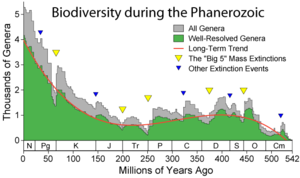Biodiversity and evolution: Difference between revisions
Funkalunatic (talk | contribs) m Undid revision 198595640 by 203.111.238.14 (talk) |
Funkalunatic (talk | contribs) |
||
| Line 7: | Line 7: | ||
There are multiple assumptions to explain [[life]] appearance, however, for the majority of scientists, life comes from [[Earth]] itself. [[Paleontology]], [[stratigraphy]] and [[biochemistry]] provide us information on the nature of first life tracks. Information is essentially drawn from observations and deductions, based on the principle that any verifiable current experimental laws, is also valid in the past. |
There are multiple assumptions to explain [[life]] appearance, however, for the majority of scientists, life comes from [[Earth]] itself. [[Paleontology]], [[stratigraphy]] and [[biochemistry]] provide us information on the nature of first life tracks. Information is essentially drawn from observations and deductions, based on the principle that any verifiable current experimental laws, is also valid in the past. |
||
The original [[origin of life]] is not well known to science, though limited evidence suggests that life may already have been well-established only a few 100 million years after the [[age of the Earth|formation of the Earth]]. Until approximately 600 million years ago, all life consisted of [[bacteria]] and similar single-celled organisms. |
The original [[origin of life]] is not well known to science, though limited evidence suggests that life may already have been well-established only a few 100 million years after the [[age of the Earth|formation of the Earth]]{{fact}}. Until approximately 600 million years ago, all life consisted of [[bacteria]] and similar single-celled organisms. |
||
==History== |
==History== |
||
Revision as of 03:09, 29 September 2008

Biodiversity found on Earth today is the result of 4 billion years of evolution. Due to many mass extinctions and the havoc wreaked upon the environment by humans, the biodiversity on Earth has been declining since humans have come into existence.
Origins of life
There are multiple assumptions to explain life appearance, however, for the majority of scientists, life comes from Earth itself. Paleontology, stratigraphy and biochemistry provide us information on the nature of first life tracks. Information is essentially drawn from observations and deductions, based on the principle that any verifiable current experimental laws, is also valid in the past.
The original origin of life is not well known to science, though limited evidence suggests that life may already have been well-established only a few 100 million years after the formation of the Earth[citation needed]. Until approximately 600 million years ago, all life consisted of bacteria and similar single-celled organisms.
History
The history of biodiversity during the Phanerozoic (the last 540 million years), starts with rapid growth during the Cambrian explosion—a period during which nearly every phylum of multicellular organisms first appeared. Over the next 400 million years or so, global diversity showed little overall trend, but was marked by periodic, massive losses of diversity classified as mass extinction events.
The apparent biodiversity shown in the fossil record suggests that the last few million years include the period of greatest biodiversity in the Earth's history. However, not all scientists support this view, since there is considerable uncertainty as to how strongly the fossil record is biased by the greater availability and preservation of recent geologic sections. Some (e.g. Alroy et al. 2001) argue that corrected for sampling artifacts, modern biodiversity is not very different from biodiversity 300 million years ago. Estimates of the present global macroscopic species diversity vary from 2 million to 100 million species, with a best estimate of somewhere near 10 million.
Most biologists agree however that the period since the emergence of humans is part of a new mass extinction, the Holocene extinction event, caused primarily by the impact humans are having on the environment. At present, the number of species estimated to have gone extinct as a result of human action is still far smaller than are observed during the major mass extinctions of the geological past. However, it has been argued that the present rate of extinction is sufficient to create a major mass extinction in less than 100 years. Others dispute this and suggest that the present rate of extinctions could be sustained for many thousands of years before the loss of biodiversity matches the more than 20% losses seen in past global extinction events.
New species are regularly discovered (on average about three new species of birds each year) and many, though discovered, are not yet classified (an estimate states that about 40% of freshwater fish from South America are not yet classified). Most of the terrestrial diversity is found in tropical forests.
